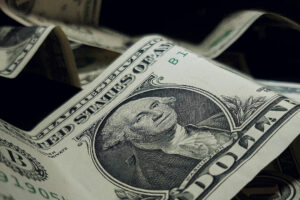Gatsby, the dollar, and staring blankly at the world falling apart: Bound for the Plaza?

(Part 1)
THOUGHTS in the currency market are turning toward the Plaza Hotel. The stately pile at the southeast corner of Central Park has a lasting place in American culture as the scene of Tom Buchanan’s confrontation with Jay Gatsby in The Great Gatsby; in the financial world, it has lasting fame as the place where world finance ministers and central bankers came together in September 1985 to agree on intervening to weaken the dollar against the West German deutsche mark and the Japanese yen. The effect was dramatic (if not as dramatic as Daisy Buchanan’s choice between her husband and her lover):
The ministerial intervention was successful and achieved what its backers wanted. The dollar has never regained its pre-Plaza highs from early 1985. But now, wishful thoughts are returning to the Plaza Accord once more. The dollar is still far below its 1985 high in nominal terms. On a real effective basis, taking account of inflation, Citibank’s index shows that it is almost back to its high since inception in 1989, after the accord was reached.
Some of the dollar cliches are true. Printing dollars does give the US “exorbitant privilege” (in the words of former French President Valery Giscard d’Estaing) and it is “our currency and your problem” (to quote President Richard Nixon’s treasury secretary, John Connally). And so it is that a succession of major economies have tried over the last week to rein in the US currency.
Japan’s Ministry of Finance intervened directly to avert the yen from falling beyond ¥145 per dollar; last Wednesday brought the Bank of England’s intervention in the gilts market, which also had the effect of arresting the pound’s descent toward parity; and on Thursday, the People’s Bank of China responded to the yuan’s weakest dollar exchange rate since 2008 by warning: “Do not bet on one-way appreciation or depreciation of the yuan, as losses will definitely be incurred in the long term.”
In all cases, sharp losses for the home currency were more or less halted. None of the interventions has as yet led to any kind of major reversal.
Interventions by three of the four largest economies outside the US in the space of a week show that the dollar’s strength is beginning to cause real stress. But there are at least two sides to any currency trade, and no meaningful limit to the dollar is possible without willing participation by the US. Hence the talk of a return to the Plaza. The logic is expressed as follows by Julian Brigden of Macro Intelligence 2 Partners.
“We’ve discussed the growing use of policy as a thumb on the economic scale. Now, with volatility rising and some markets threatening to seize up, policymakers appear to have seen the size of the economic shark they are fighting and had the thought that, with apologies to Jaws, they’re ‘going to need a bigger thumb.’”
If not a full-blown formal repeat of Plaza, there are at least hopes of a new version of the informal 2016 Plaza Accord, when dollar strength caused problems for China, and the Fed decided to hike rates only once during the year, rather than the four times it had previously guided the market to expect. The shifts in the financial tectonic plates are already causing alarm, while the Ukrainian conflict has driven a sharp devaluation for European currencies compared to the dollar. A strong dollar has also driven several emerging market crises in the past.
However, the story is more complicated. The Institute of International Finance (IIF) points out that the dollar has been far stronger with respect to the developed world than to emerging markets.
According to the IIF’s estimates of fair value, the euro and the pound are still overvalued and have further to fall, despite the damage they have already sustained. That might vitiate any Plaza-style attempt to limit the dollar. And it also confirms that this dollar surge is likely to create more pain in western Europe than in the emerging world.
Beyond that, the forces driving the dollar are strong, and not going away. To quote Fiona Cincotta of City Index:
“There’s nowhere to hide. There’s still some dollar strength to come. If we just think about what’s going on with the dollar, it’s being supported by safe haven flows, it’s been supported by a very hawkish Fed. It’s not showing any signs of really slowing down in that hiking cycle right now. And also, there’s no alternative… You don’t want to be going near the euro right now, given the energy crisis, the inflation troubles over the state of the economy… There’s nothing that’s appealing about the pound given the concerns over the outlook for the UK economy.”
Or, as Nick Carraway in Gatsby might have put it, the dollar is the pursued, and everyone else is pursuing, busy or tired. Weakening it would be hard. In any case, the US isn’t on board for doing so, for a list of reasons covered by Morgan Stanley’s economics team:
“First and most importantly, a weaker USD runs counter to what the Fed and Treasury are trying to achieve: lower inflation. A weaker dollar is, on net, inflationary in the US and deflationary abroad; foreign currency appreciation supports higher external demand. While US inflation is elevated, it seems difficult to countenance why the US would proactively participate in an inflationary dollar policy, and without US participation, we see little chance of success.”
Beyond that, they couldn’t do another Plaza if they wanted to, because of lack of ammunition:
“We think that policymakers are aware of a hard truth: They don’t have enough FX reserves to make a sustained difference. Back in 1985-87, the last time we had a coordinated intervention to weaken USD, daily FX turnover was near $200 billion per day (on a net-gross basis) but, as of the last reported BIS figure in 2019, daily turnover is over 40 times higher at $8.3 trillion per day. The G10 collectively has $2.8 trillion in FX reserve assets (deposits and securities, so excluding gold).”
The bottom line is that despite the growing problems the rising dollar is causing for the world, we won’t be returning to the Plaza any time soon. The non-dollar economies may have each other’s company, but in another pearl from Gatsby, they must feel like “they are watching their whole world fall apart, and all they can do is stare blankly.”
(To be continued.)
BLOOMBERG OPINION




